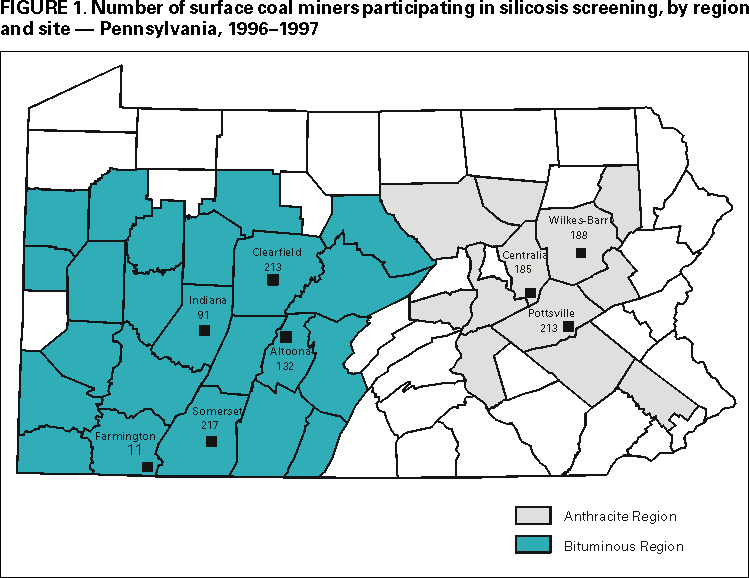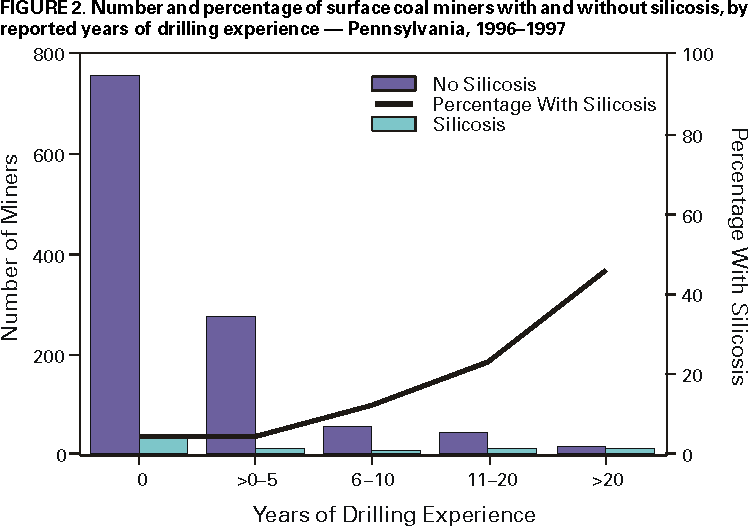 |
|
|
|
|
|
|
| ||||||||||
|
|
|
|
|
|
|
||||
| ||||||||||
|
|
|
|
|
Persons using assistive technology might not be able to fully access information in this file. For assistance, please send e-mail to: mmwrq@cdc.gov. Type 508 Accommodation and the title of the report in the subject line of e-mail. Silicosis Screening in Surface Coal Miners --- Pennsylvania, 1996--1997Silicosis is an occupational respiratory disease caused by inhaling respirable crystalline silica dust. Silicosis is irreversible, often progressive (even after exposure has ceased), and potentially fatal. Exposure to silica dust occurs in many occupations, including mining (1). During 1996--1997, surface coal miners at eight sites in Pennsylvania were screened to estimate the prevalence of silicosis, to identify risk factors for silicosis, and to refer miners with a possible diagnosis of silicosis or other conditions for medical evaluation and treatment. This report summarizes the results of the screening, which indicated that an increased prevalence of and risk for silicosis is associated with miners' age and years of drilling experience, and provides recommendations for preventing silicosis among miners. Enrollment in the screening was voluntary and available to anyone who had worked in surface mining for 1 year or more. Surface miners were informed of the screening by Mine Safety and Health Administration (MSHA) inspectors during routine mine visits. Screening was performed by a multiagency team from the Chronic Respiratory Disease Program of the Pennsylvania Department of Health (team leader), the Department of Health Evaluation Sciences of the Pennsylvania State University College of Medicine, MSHA, and CDC's National Institute for Occupational Safety and Health (NIOSH). Screening was conducted during May--June 1996, at five mine sites in bituminous coalfields in western Pennsylvania (Altoona, Clearfield, Farmington, Indiana, and Somerset) and, in June 1997, at three mine sites in anthracite coalfields in eastern Pennsylvania (Centralia, Pottsville, and Wilkes-Barre). The screening was divided by coal type and region because of differences in geology and mining practices. Screening consisted of anterior-posterior chest radiographs; spirometry; and a survey containing questions about demographics; medical, work, and smoking history; and workplace exposures. Silicosis was defined as a radiographic finding of International Labour Organization (ILO) classification of profusion category >1/0 (2); classification was based on consensus of at least two of three NIOSH-certified B readers*. Descriptive analyses were performed on all variables collected from the radiographs, spirometry, and surveys. Multivariable logistic regression models were used to determine risk factors for developing silicosis. During 1996--1997, 1250 current and former coal miners were screened at the eight sites (664 in western and 586 in eastern Pennsylvania); and data from 1236 miners were suitable for analysis (Figure 1). Screened miners were almost exclusively white (99.9%), male (99.5%), and non-Hispanic (97.6%); the mean age was 46.2 years (range: 18--87 years). Of 1221 miners, 289 (23.7%) were current smokers, and 729 (59.7%) had ever smoked; 1120 (90.7%) of 1235† were employed full-time. Radiographic evidence of silicosis was found in 83 (6.7%) of 1236 screened miners. Prevalence of silicosis did not vary by smoking status, and no significant differences in prevalence were noted by site except among the 213 participants at Clearfield (16.0%; p=0.001). When data from Clearfield were excluded, the prevalence of silicosis was similar for western (5.2%) and eastern (4.5%) Pennsylvania. The odds ratio (OR) for silicosis at the Clearfield site compared with other western sites was 4.4 (95% confidence interval [CI]=2.3--8.5); the OR for silicosis at eastern sites was 1.1 (95% CI=0.6--2.1) compared with western sites, excluding Clearfield. The mean age of miners with silicosis was 50.6 years and without silicosis was 45.6 years (p=0.0002). When age was modeled as a quadratic function in the logistic regression model, a significant increase in silicosis occurred with increasing age. Compared with miners aged 30 years, miners aged 40, 50, and 60 years had progressively increased odds of silicosis: 3.7 (95% CI=1.7--8.2), 7.8 (95% CI=2.4--25.3), and 9.7 (95% CI=3.0--31.6), respectively. Silicosis prevalence increased as the number of reported years of drilling experience increased, from 37 (4.7%) of 792 miners reporting no drilling experience to 12 (46%) of 26 in miners reporting >20 years experience (Figure 2). Compared with miners with <5 years of drilling experience, those who had 6--10, 11--20, and >20 years experience had progressively increased odds of silicosis: 4.3 (95% CI=1.6--11.8), 7.0 (95% CI=2.6--18.6), and 14.5 (95% CI=4.8--43.6), respectively. Reported by: PA Tyson, MSW, Chronic Respiratory Disease Program, Pennsylvania Dept of Health. JL Stauffer, MD, EA Mauger, PhD, JE Caulfield, MS, Pennsylvania State Univ College of Medicine, Hershey. DW Conrad, KG Stricklin, Mine Safety and Health Administration, US Dept of Labor. Div of Respiratory Disease Studies; Office for Mine Safety and Health, Pittsburgh Research Laboratory, National Institute for Occupational Safety and Health, CDC. Editorial Note:This report underscores the risk for silicosis associated with surface coal mining operations. Previous studies identified an increased risk for silicosis among rock drillers (3), and this report corroborates the increased prevalence of silicosis among surface coal mining drillers (4,5). The findings in this report are subject to at least four limitations. First, the sample was voluntary and represented approximately 40% of Pennsylvania surface coal miners (63% of anthracite miners and 29% of bituminous miners§); therefore, the results do not necessarily represent all surface coal miners in Pennsylvania or the United States. Silicosis prevalence may be underestimated if miners with confirmed or suspected silicosis did not participate or may be overestimated if a higher percentage of affected workers participated. Second, B reader variability in the interpretation of chest radiographs was a possibility, although the study methods were designed to limit the effects of reader variability (6). Third, prevalence differences across sites must be interpreted cautiously; miners were not restricted in their choice of screening site, and the latency period for silicosis, several years to several decades following exposure, makes it difficult to determine a specific source of exposure in workers. Finally, the study collected data on years of drilling experience and not on years of overall mining experience; some miners may have performed numerous duties at different mines throughout the region. According to MSHA part 50 data for 1996 and 1997, Pennsylvania had almost one third of the U.S. surface coal mines; however, because of the many small operations in Pennsylvania, 3205 (approximately 10%) of the 31,308 surface coal miners in the United States are employed in Pennsylvania. Smaller mine operations may lack resources required to purchase or maintain optimal dust-control equipment, and small-scale operations represent special challenges for enforcement activities. The reason for the higher silicosis prevalence at Clearfield is unknown; however, influences may include site-specific geologic factors (e.g., quartz content of overlying rock), past work practices, mining methods, types of controls, or machinery maintenance. Because no effective treatment exists for silicosis, prevention through exposure control is essential (7). When proper practices are not followed or controls are not maintained, silica exposures can exceed the MSHA Permissible Exposure Limit (PEL) or the NIOSH Recommended Exposure Limit (REL)¶. Effective engineering controls in the mining environment include dust suppression (e.g., wet drilling), dust collection (e.g., dry drilling with particulates exhausted through a dust collection system), and use of enclosed isolation systems (e.g., air conditioned cabs under positive pressure and equipped with both filtered air supply and filtered recirculated air). In 1994, MSHA and NIOSH implemented a regional, and later a national, silicosis prevention program that promoted educational efforts and allowed coal mine inspectors to issue citations on the basis of visual inspection of dust-producing drilling equipment rather than more extensive sampling (8). As a result, some high-risk equipment has been discarded by the mines; however, because of the long latency period that usually precedes clinical onset of silicosis, the impact of these reforms on the incidence of silicosis remains unclear. References
* A physician certified by NIOSH as having competency in the classification of chest radiographs to detect pneumoconiosis using ILO guidelines. If at least two of the three B readers categorized the profusion as >1/0, the miner was classified as having silicosis; if at least two readers indicated the film was negative (<1/0), the miner was classified as not having silicosis. †Denominators vary because of nonresponse to specific questions. § Data from MSHA, part 50. The Federal Mine Safety and Health Act of 1977 requires all mine operators to record and report to MSHA data on occupational injuries; illnesses; certain noninjurious accidents; and related employment, work time, and operating activity information. MSHA data cited for number of employees are for mine operator employees only; state-specific data are not available for contractor employees. ¶ PEL for coal mining is 2.0 mg of respirable coal dust per cubic meter of air (2 mg/m3); however, when the respirable quartz (crystalline silica) content of the dust exceeds 5%, a reduced PEL is computed by dividing the percentage of respirable quartz into the number 10 (Title 30, Code of Federal Regulations, Part 71.101). NIOSH-recommended exposure limit (REL) for respirable crystalline silica is a 10-hour, time-weighted average level of 50 µg/m3. Figure 1  Return to top. Figure 2  Return to top. Disclaimer All MMWR HTML versions of articles are electronic conversions from ASCII text into HTML. This conversion may have resulted in character translation or format errors in the HTML version. Users should not rely on this HTML document, but are referred to the electronic PDF version and/or the original MMWR paper copy for the official text, figures, and tables. An original paper copy of this issue can be obtained from the Superintendent of Documents, U.S. Government Printing Office (GPO), Washington, DC 20402-9371; telephone: (202) 512-1800. Contact GPO for current prices. **Questions or messages regarding errors in formatting should be addressed to mmwrq@cdc.gov.Page converted: 7/13/2000 |
|||||||||
This page last reviewed 5/2/01
|